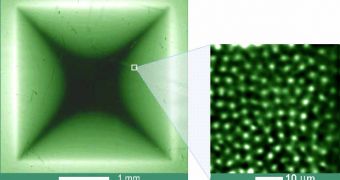Present information technologies rely on electrons for carrying process data and information, but, as silicon technology is reaching its physical limits, researchers are looking for alternatives.
Another emerging field is "spintronics", that deals with the use of the "spin" of an electron for storing, processing and communicating information, and it has known an important recent advance that may one day manifest itself in a new generation of smaller, smarter and faster computers, sensors and other devices.
The latest proposal is the magnetic flux. Since single electrons can't be pinned down, and their spin-orientation is not permanent, the best solution could be to use flux quanta.
Flux quantization is a quantum phenomenon in which the magnetic field is quantized in the unit of h / 2e, also known variously as flux quanta, fluxoids, vortices or fluxons. It occurs in Type II superconductors subjected to a magnetic field. Below a critical field Hc1, all magnetic flux is expulsed according to the Meissner effect and a perfect diamagnetism is observed, exactly as in a Type I superconductor. Up to a second critical field value, Hc2, flux penetrates in discrete units while the bulk of the material remains superconducting. Both critical fields are temperature dependent, and tabulated values are the zero-temperature extrapolation unless otherwise noted.
Now, researchers at the Paul Drude Institute for Solid State Electronics (PDI) in Berlin have demonstrated how extremely small and intensive magnetic fields can be manipulated. The researchers, lead by Dr. Carsten Hucho found a way to move the smallest possible magnetic entities - the flux quanta - with the help of sound waves.
These very small magnetic fields, also called vortices, remain stable for a theoretically infinite period of time. "We can keep track of an individual flux quantum and now we can move the flux around", says Hucho.
They managed to transport magnetic flux quanta with a surface acoustic wave. The vortices move with the soundwave like on a conveyor-belt. So will these new findings accelerate the development of so-called "fluxtronics" after electronics and spintronics? Hucho cautions that "there is still a long way to go." The main goal of the study was to show that magnetic flux quanta in superconductors can be manipulated in a well-defined way.
But future applications, even if distant, are promising, with far-reaching technological consequences, even besides the storage and processing of data. For instance, tiny magnetic particles could be transported in some sort of conveyor belt, this being of interest for molecular analytics.

 14 DAY TRIAL //
14 DAY TRIAL //